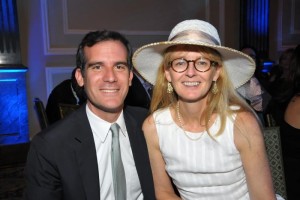
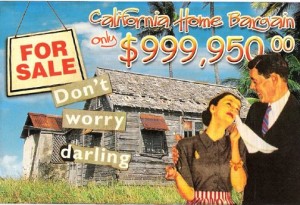
Continue reading HPOA Precursor Organization and Former Employer of Kerry Morrison California Real Estate Association Sought to Warp, Pervert, and Destroy U.S. Constitution in 1948 to Prevent “The Threat of Occupancy by Negroes”


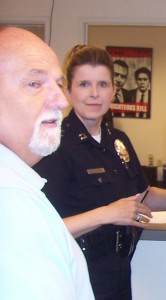
First we have facilitator Peter Robinson, now at Pepperdine. We don’t have much to say about him except that, according to his Pepperdine bio, he’s got an excellent sense of humor. He’d have to have, wouldn’t he?

Continue reading In Rare Conflict with BID LAPD Deputy Chief Beatrice Girmala Exercises Totalitarian Veto Power over Private Real Estate Transactions in Hollywood, Insinuates that Protecting, Serving Homeless is Waste of LAPD Time

Next, and much, much more interesting, we have some records produced by the Media District between 2009 and 2011 when they were involved in some kind of mediation process with the Greater West Hollywood Food Coalition. Again, these are available via via static storage or through a local page. And finally, read below the fold for the real kicker.
Continue reading A Bunch of New Documents: Street Characters Lawsuit, GWHFC Mediation, Greenshirt Daily Activity Reports

Well, Judge Michael W. Fitzgerald of the U.S. District Court for the Central District of California (that’s federalese for “Los Angeles”) not only dismissed Inglewood’s case, he terminated it with extreme prejudice. You can read the order here if you wish, and it’s smoking hot. The salient bit for this blog is, according to Volokh, that:
The court held that, under California law (see, e.g., County of Santa Clara v. Superior Court (Cal. Ct. App. 2009)), cities can’t claim copyright in public records. And while the city claims that this provision is trumped by federal copyright law, the court rejected that argument — federal law treats local governments as political subdivisions of the state, and a state has the power to control what its subdivisions do (including which federal rights they claim).
Now, I can hear you all murmuring and wondering out there in internetlandia, saying “sure, Kohlhaas, we hear you, but what does this got to do with the BIDs??!” Well, friends, we’re glad you asked!
Continue reading Federal Judge Michael W. Fitzgerald of the U.S. District Court for the Central District of California Shows Up BIDs for the Mewling and Puking Liars they Are
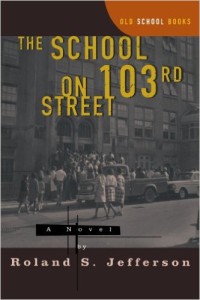
I’ll move on to the serious matters below, but first, check this description of protagonists Elwin Carter and Sable having an evening out in 1973:
Now, I don’t just read novels for Los Angeles geography porn, but I’m always happy to find it, especially when it has restaurants! Cyrano was a “fine dining” or “continental” sort of place, opened early on in Marina Del Rey. Given the character of the Marina in 1973, at the time Elwin and Sable had dinner there the joint was probably full of cocaine, swinging-in-the-worst-sense, disgusting 1970s facial hair, and gelatinous sleaze coating every surface. 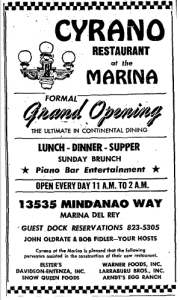
The Name of the Game was a dance place in Inglewood at Century and Crenshaw. Here’s how the Los Angeles Sentinel described it on September 2, 1971:
It’s called The Name of The Game, and to many, many persons it’s the name of the place they find attractive and a lively cynosure for a truly good evening of pleasure. Located at 3000 W. Century boulevard, it has music by Dave Holden, and dancing space for frisky feet or those who just love to move and groove. There’s no cover charge, either. The Name of the Game also affords daily luncheon specials, and daily half-price cocktails. So what could be better for the jaded tastes than a visit to The Name of the Game?4
Unfortunately I can’t find a picture of the place. Note also that there was a sensational killing there in 1973. I don’t have space to go into it, but it was well covered in the Sentinel, starting here.11
Next they head off to the Lighthouse, a famous and still-active jazz club in Hermosa Beach which I’d discuss more if I gave even a fraction of a shit about either jazz or Hermosa Beach. Finally, “on the way home,” they head to Shelley’s Manne Hole which, coincidentally, played an important role in my last recommendation, so I won’t belabor it here. However, these two live in Baldwin Hills, meaning that the Manne Hole, at 1608 N. Cahuenga Blvd., is in no sense but the sense that this night should never end on the way home from Hermosa Beach. Ah, youth!
Now, despite my breathless temporogeographical musings, this novel is much more than a travelogue. It’s an immensely important document about the state of racial politics in Los Angeles eight years after the Watts Rebellion, with more than a little relevance for the present day (as well as being a bitchin’ thriller). Read on for details!
Continue reading The School on 103rd Street

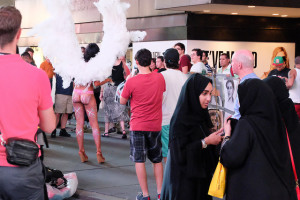

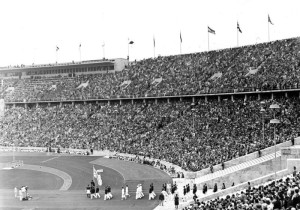
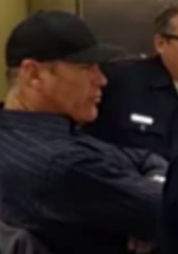
Good evening. My name is John Tronson. I’m a member of the Hollywood Entertainment District, which is a property-owner based business improvement district in Hollywood.
All these people start off by saying something true. It’s meant to lull your suspicions. Don’t let it.

The way a property-based BID works is this: If the majority of the property owners in a district agree, the city adds an extra assessment to their property tax, keeps some part of the money raised for administrative overhead, and distributes the rest back to the BID to spend on specific kinds of services in the district. There are two important points to remember. First, a BID can be established over the objection of individual property owners. Only a majority need approve. Second, once a BID is established, the assessment is no longer voluntary. It is compulsory. Non-payment is punishable by the full range of state action2 up to and including violent confiscation of property. In other words, this assessment, once paid, is a tax. After all, income tax might be considered voluntary in this same sense. The Sixteenth Amendment to the Constitution was put in place by elected representatives, so in a way, the people to be taxed consented to the taxation. But now that it’s in place, income tax is no longer voluntary, just as BID assessments are no longer voluntary. This is consistent with the standard definition:
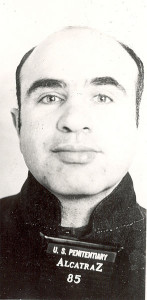
Now, everyone who pays taxes has, at one point or another, thought of that money as still their own. But really, it’s not. Try telling a cop not to give you a ticket because you pay their salary with your “own money.” Try telling a professor at UCLA they have to give your kid an A+ because it’s your “own money” that supports them. It’s a losing argument. Taxes, once paid, belong to the public, not to the people who paid them. BID assessments are taxes. BID assessments are public money. Now, as to John’s statement about what they do with that public money, it’s true as far as it goes. That’s not all they spend the money on, but they do spend it on that. We won’t argue. Onward!
Continue reading John Tronson in Van Nuys: Money doesn’t talk, it swears1
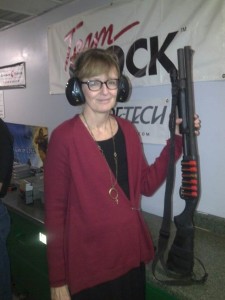
there were a series of four hearings that the chief administrative office staff held on the… the sidewalk vending ordinance. … It’s just this kind of amorphous set of hearings, which were completely dysfunctional, disrespectful, and almost, um, resembled a circus.
In the same meeting, Kerry explained that she wasn’t putting up with this, not for a second, and told everyone what she’d done about it:
So actually, Carol Schatz and I wrote a letter to Herb Wesson, the president of the city council after that meeting saying this is, this is really not being, you know, well-handled, there’s no security, it’s intimidating to people, there are people who did not want to testify. So the subsequent two hearings were, um, maybe a little bit more well-behaved.

The lyrics are cruder than Kerry Morrison’s, but the tune’s the same.2
Continue reading Kerry Morrison in Van Nuys: Where the home in the valley meets the damp dirty prison / Where the executioner’s face is always well hidden1
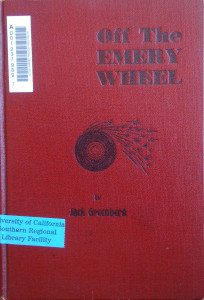 The other day I got the urge to read a little more about Thurgood Marshall. The Los Angeles Public Library’s catalog led me to a book by badass civil rights lawyer Jack Greenberg (read it, it’s fabulous: Crusaders in the Courts, although it’s not the book I’m recommending). That led me to look for other books by Greenberg, and thus appeared before me a book called Off the Emery Wheel which, as you can see, was published in 1935 by an outfit in Hollywood called the Cloister Press. Clearly this was a different Jack Greenberg, but nevertheless I thought it’d be interesting to take a look.
The other day I got the urge to read a little more about Thurgood Marshall. The Los Angeles Public Library’s catalog led me to a book by badass civil rights lawyer Jack Greenberg (read it, it’s fabulous: Crusaders in the Courts, although it’s not the book I’m recommending). That led me to look for other books by Greenberg, and thus appeared before me a book called Off the Emery Wheel which, as you can see, was published in 1935 by an outfit in Hollywood called the Cloister Press. Clearly this was a different Jack Greenberg, but nevertheless I thought it’d be interesting to take a look.

The LAPL’s only copy is noncirculating, and, while a trip to the big library downtown is always nice even though it’s not plausible anymore to combine it with a visit to Grand Central Market since the goddamned-hipster-douchebag apocalypse and its associated fourteen dollar “revisionings” of the Egg McMuffin and suchlike nonsense, I didn’t really have time. However, I’ve been spending a lot of time in the stacks at UCLA, working on a historical project which you’ll read about here at some point, I’m sure (and which is at least somewhat related to the Hollywood BIDs, unlike this piece) so I thought I’d check their catalog. Well, Lo! And behold, they own a copy, which I promptly ordered up out of storage.

And what a pleasant little volume to hold this turned out to be! 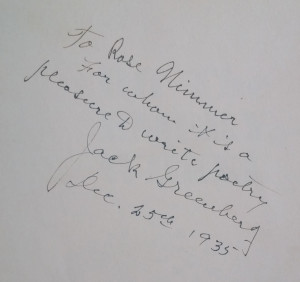

Continue reading Off the Emery Wheel